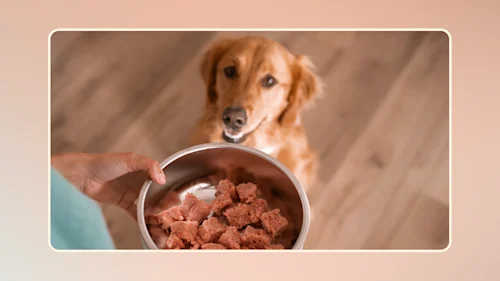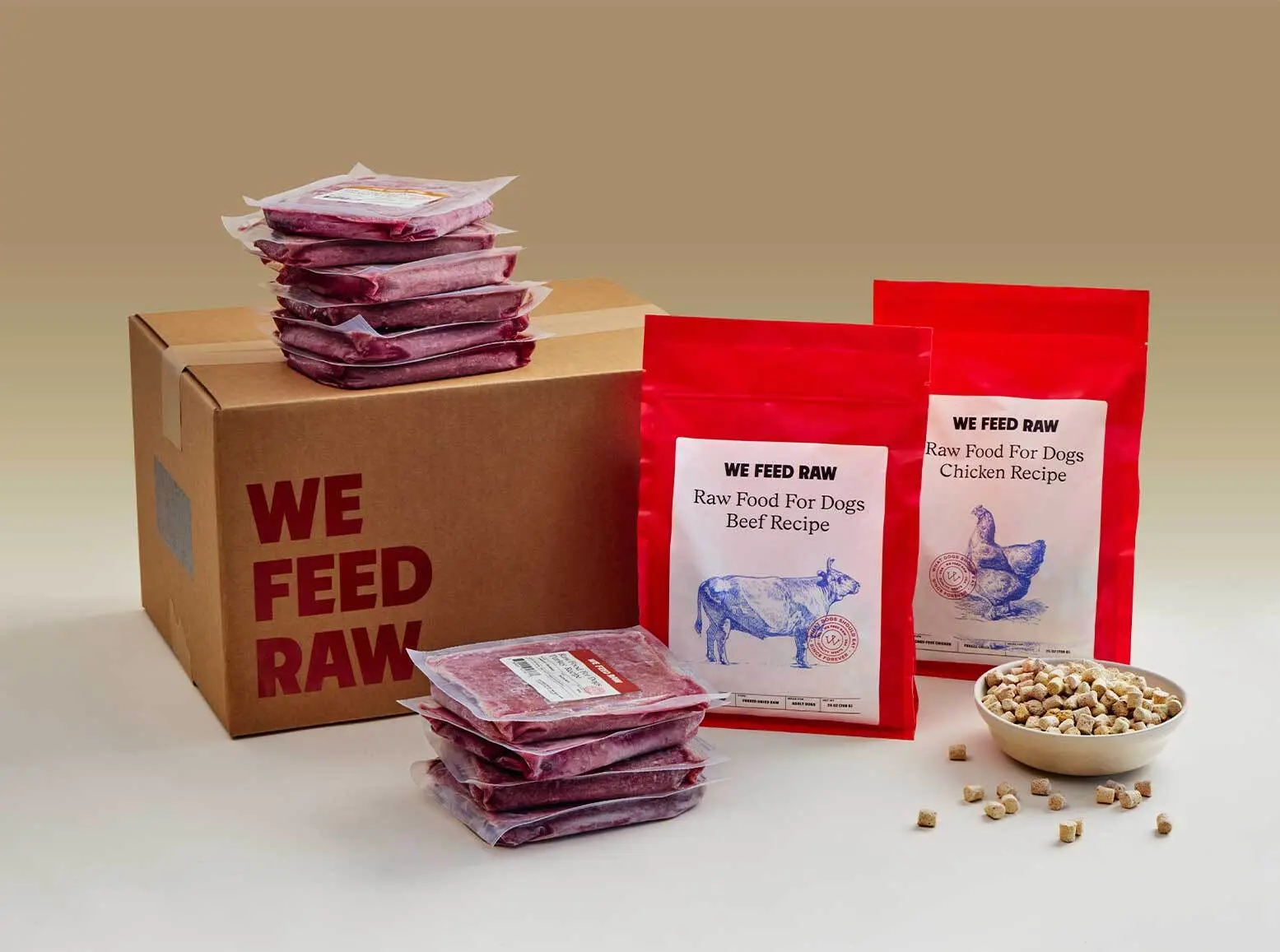
The Complete Guide to Switching Your Dog to a Raw Diet from Kibble
Table of Contents
- Transitioning to Raw 101: How to Introduce Raw Food to Dog
- How to Transition From Kibble to Raw: A Step-by-Step Guide
- Assistance From We Feed Raw in Transitioning Dog to Raw Diet
- What to Expect When Switching from Kibble to Raw
- Observing Changes in Stool and Water Intake after Transition to Raw Dog Food
- Getting Started With We Feed Raw on How to Transition Dog to Raw Food
- Frequently Asked Questions (FAQs)
Switching from kibble to a raw diet can sound overwhelming at first, especially if your pup already has an established diet. However, the benefits of changing from kibble to raw food make it all worth it in the long term. If you’re ready to make the switch, here’s some advice that can help the transition to raw feeding go smoothly.
Transitioning to Raw 101: How to Introduce Raw Food to Dog
You might think your dog will instantly jump at the opportunity to eat fresh, raw food. But that’s not always the case.
Understanding Your Dog's Initial Reaction to Raw Food
Many dogs are accustomed to their dry food and might turn their noses up at a raw meal because it looks different, feels different, and, believe it or not, doesn’t have the same intense aroma as kibble. (Kibble manufacturers use spray-on flavors with enhanced scents to entice dogs.)
That’s why it’s important to be patient during the change from kibble to raw food. Your dog has always eaten one type of food, and now you're presenting them with something totally different. Give them some time to "learn" that what you're feeding them is actually food they'll want to eat.
Strategies to Make Raw Meals Attractive
In the meantime, you can make their meals more enticing with a little cheese, a sprinkling of their favorite treat, an egg, canned sardines (in water), low-sodium bone broth, goat's milk, or other appetizing flavors.
One of our favorite tricks? Try lightly searing the meat, which releases delicious aromas. Over time, gradually reduce how much you sear the food until your dog starts eating their meals completely raw.
How to Transition From Kibble to Raw: A Step-by-Step Guide
Another key component to successfully transitioning your dog to raw is to do it slowly over a 10-day period. You should start by making your pet’s meal 75% of their old pet food and 25% new raw food. Then increase the amount of new food by 25% every few days.
For example: Days 1-3: Feed 25% raw, 75% of their previous food. Days 4-6: Feed 50% raw, 50% of their previous food. Days 7-9: Feed 75% raw, 25% of their previous food. By day 10, you should be able to feed 100% raw.
Please note that not all dogs transition at the same rate. Some dogs may transition quickly without any digestive issues and some may require a longer transition period. Don't get discouraged if your dog ends up in the latter category.
Introducing raw dog food in small amounts is best if your pet has a sensitive stomach. This way, you can closely monitor their reaction to the new food. It also allows you to experiment with different feeding proportions of kibble and raw food if you’re not making a complete transition.
Assistance From We Feed Raw in Transitioning Dog to Raw Diet
At We Feed Raw, we give every new customer a transition box and detailed instructions with their first order. This includes everything you need to transition your dog to a raw diet over a 10-day period.
What to Expect When Switching from Kibble to Raw
When switching a pet over from kibble to a raw food diet, their body might begin the process of expelling toxins and impurities as it adjusts to the consumption of proper nutrients. This so-called “detox” may last a couple of days, one week, one month, several months, or in some cases, not at all.
Common symptoms of detox include vomiting, loose stools, bad breath, and flatulence. For loose stools, you can add some plain canned organic pumpkin (nothing added) to their meals, which will help to firm up stools and regulate the digestive system. We also recommend adding a good pre/probiotic to their meals before and during the transition. Just remember that your dog's digestive system was designed to process a raw meat-based diet, and the detox is a normal part of the transition process.
Observing Changes in Stool and Water Intake after Transition to Raw Dog Food
As your dog switches from kibble to raw food, you might notice changes in their stool. Your pup may be pooping less because most of the food they are currently ingesting is being digested and properly used by the body, resulting in less waste. The bone content in your pet's new diet also accounts for it turning white in some cases.
Mucus-covered stools can appear at any time, no matter how long a dog has been on the raw diet, and is generally no reason for concern. When first switching to a raw diet, this may be a sign that the digestive tract is ridding junk from its system.
The raw diet is about 70% moisture and is low in sodium. Because kibble has had the water removed, dogs constantly have to drink to stay properly hydrated. And while they'll most certainly drink less on the raw diet, it's still important to always provide your pet with access to fresh, clean water.
Every Dog Is Different
At the end of the day, every dog is different. Some may adapt to the raw diet almost immediately without a problem. Others may need more time and experience digestive symptoms as their body adjusts to the raw food.
Whatever the case, We Feed Raw is here to help with our unique transition plan and high-quality pre-made raw meals for pets.
Getting Started With We Feed Raw on How to Transition Dog to Raw Food
Want to get a custom meal plan for your furry friend? Get started today.
Frequently Asked Questions (FAQs)
What is the most effective way to transition my dog to a raw diet?
Transitioning your dog to a raw diet should be done gradually over a 10-day period. Start by making your pet's meal consist of 75% of their old pet food and 25% new raw food. Then increase the amount of new food by 25% every few days.
How can I smoothly transition from kibble to raw?
Smooth transitioning from kibble to raw can be done by taking it slow. Start by incorporating small amounts of raw food into your dog's kibble diet. Slowly increase the raw portions while decreasing the kibble until your dog is fully on a raw diet.
Can you provide some tips for transitioning from kibble to raw?
Sure! First, do it gradually—don't make the switch overnight. Second, make the meals more appealing by adding some cheese or their favorite treat. Lastly, monitor your dog's response, especially if they have a sensitive stomach.
What are some guidelines on how to transition to raw dog food?
Start by introducing raw food in small amounts. Monitor your dog's reaction, adjust feeding proportions as needed, and stay patient. Remember, your dog's digestive system was designed to process a raw meat-based diet.
What should I consider when switching my dog from kibble to raw food?
Monitor the changes in their stool, as this is a good indicator of how well your dog is adjusting to the raw diet. Keep in mind your dog's hydration needs, as they may drink less with a raw food diet. Finally, be prepared for a potential “detox” period as their body adjusts to the new diet.
How can I introduce raw food to my dog without upsetting their stomach?
Introduce raw dog food in small amounts, especially if your pet has a sensitive stomach. This will allow you to monitor their reaction to the new food and adjust proportions as needed. You can also add some plain canned organic pumpkin to their meal to help firm up their stools.
What are the steps to transitioning my dog to raw dog food?
Start by introducing a small amount of raw food to their diet, while gradually reducing the kibble. Over a 10-day period, gradually increase the raw portions until your dog's meal is 100% raw.
How do I start transitioning my dog to a raw diet without causing digestive issues?
Start slow and monitor their reaction closely. Not all dogs transition at the same rate— some may require a longer transition period. If your dog has a sensitive stomach, introduce raw dog food in small amounts and gradually increase.
How do I effectively transition my dog to raw food?
Begin by incorporating small amounts of raw food into your dog's kibble diet. Each day, slightly increase the raw food portion while decreasing the kibble until you're feeding your dog 100% raw food. This process should be done gradually over a 10-day period.

Our Meals Change Lives.
(Theirs + Yours.)
See health improvements from our raw meals in as little as 1 week.
